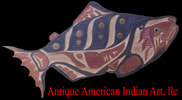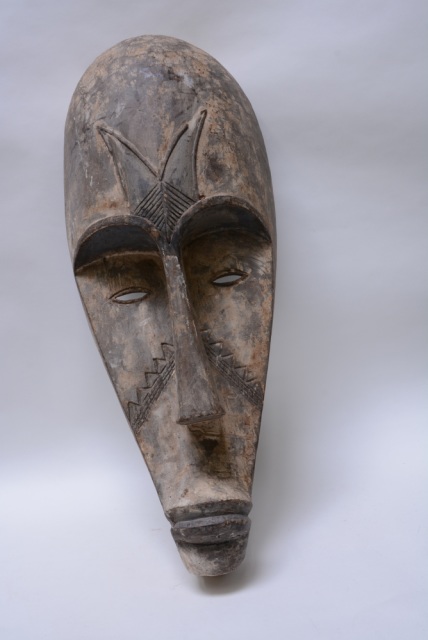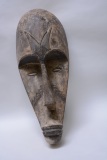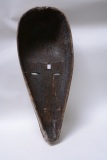- The Artifact Collection Gallery Catalog
- >
- African Art
- >
- 160901-15 Large African Mask
160901-15 Large African Mask
SKU:
160901-15
$595.00
$595.00
Unavailable
per item
29" x 12" x 7 1/2"
A mask used in ngil magic ceremonies of the Fang people of Gabon, central west coast, Africa.. Similar example at the Ethnological Museum of Berlin. From a private Texas collection.
Ritual and ceremonial masks are an essential feature of the traditional culture of the peoples of a part of Sub-Saharan Africa, e.g. roughly between the Sahara and the Kalahari Desert. While the specific implications associated to ritual masks widely vary in different cultures, some traits are common to most African cultures. For instance, masks usually have a spiritual and religious meaning and they are used in ritual dances and social and religious events, and a special status is attributed to the artists that create masks to those that wear them in ceremonies. In most cases, mask-making is an art that is passed on from father to son, along with the knowledge of the symbolic meanings conveyed by such masks. African masks come in all different colours, such as red, black, orange, and brown.
African countries where masks are used traditionally
Traditional African masks are one of the elements of great African art that have most evidently influenced Europe and Western art in general; in the 20th century, artistic movements such as cubism, fauvism and expressionism have often taken inspiration from the vast and diverse heritage of African masks.[1] Influences of this heritage can also be found in other traditions such as South- and Central American masked Carnival parades.[2]
A mask used in ngil magic ceremonies of the Fang people of Gabon. Ethnological Museum of Berlin
In most traditional African cultures, the person who wears a ritual mask conceptually loses his or her human identity and turns into the spirit represented by the mask itself.[3] This transformation of the mask wearer into a spirit usually relies on other practices, such as specific types of music and dance, or ritual costumes that contribute to conceal the mask-wearer's human identity. The mask wearer thus becomes a sort of medium that allows for a dialogue between the community and the spirits (usually those of the dead or nature-related spirits). Masked dances are a part of most traditional African ceremonies related to weddings, funerals, initiation rites, and so on. Some of the most complex rituals that have been studied by scholars are found in Nigerian cultures such as those of the Yoruba and Edo peoples, that bear some resemblances to the Western notion of theatre.[4]
Since every mask has a specific spiritual meaning, most traditions comprise several different traditional masks. The traditional religion of the Dogon people of Mali, for example, comprises three main cults (the Awa or cult of the dead, the Bini or cult of the communication with the spirits, and the Lebe or cult of nature); each of these has its pantheon of spirits, corresponding to 78 different types of masks overall. It is often the case that the artistic quality and complexity of a mask reflects the relative importance of the portrayed spirit in the systems of beliefs of a particular people; for example, simpler masks such as the kple kple of the Baoulé people of Côte d'Ivoire (essentially a circle with minimal eyes, mouth and horns) are associated to minor spirits.[5]
---
The Ngil (sometimes referred to as the gorilla mask) masks were worn by members of a male society of the same name during the initiation of new
members and the persecution of wrong-doers. Masqueraders, clad in raffia costumes and attended by helpers, would materialize in the village
after dark, illuminated by flickering torchlight. Fang masks, such as those worn by itinerant troubadours and for hunting and punishing sorcerers,
are painted white with facial features often outlined in black. Typical are large, elongated masks covered with kaolin and featuring a face that was
usually heart-shaped with a long, fine nose. The Ngil society disappeared with the beginning of the colonization of Gabon in the early 1930's.
A mask used in ngil magic ceremonies of the Fang people of Gabon, central west coast, Africa.. Similar example at the Ethnological Museum of Berlin. From a private Texas collection.
Ritual and ceremonial masks are an essential feature of the traditional culture of the peoples of a part of Sub-Saharan Africa, e.g. roughly between the Sahara and the Kalahari Desert. While the specific implications associated to ritual masks widely vary in different cultures, some traits are common to most African cultures. For instance, masks usually have a spiritual and religious meaning and they are used in ritual dances and social and religious events, and a special status is attributed to the artists that create masks to those that wear them in ceremonies. In most cases, mask-making is an art that is passed on from father to son, along with the knowledge of the symbolic meanings conveyed by such masks. African masks come in all different colours, such as red, black, orange, and brown.
African countries where masks are used traditionally
Traditional African masks are one of the elements of great African art that have most evidently influenced Europe and Western art in general; in the 20th century, artistic movements such as cubism, fauvism and expressionism have often taken inspiration from the vast and diverse heritage of African masks.[1] Influences of this heritage can also be found in other traditions such as South- and Central American masked Carnival parades.[2]
A mask used in ngil magic ceremonies of the Fang people of Gabon. Ethnological Museum of Berlin
In most traditional African cultures, the person who wears a ritual mask conceptually loses his or her human identity and turns into the spirit represented by the mask itself.[3] This transformation of the mask wearer into a spirit usually relies on other practices, such as specific types of music and dance, or ritual costumes that contribute to conceal the mask-wearer's human identity. The mask wearer thus becomes a sort of medium that allows for a dialogue between the community and the spirits (usually those of the dead or nature-related spirits). Masked dances are a part of most traditional African ceremonies related to weddings, funerals, initiation rites, and so on. Some of the most complex rituals that have been studied by scholars are found in Nigerian cultures such as those of the Yoruba and Edo peoples, that bear some resemblances to the Western notion of theatre.[4]
Since every mask has a specific spiritual meaning, most traditions comprise several different traditional masks. The traditional religion of the Dogon people of Mali, for example, comprises three main cults (the Awa or cult of the dead, the Bini or cult of the communication with the spirits, and the Lebe or cult of nature); each of these has its pantheon of spirits, corresponding to 78 different types of masks overall. It is often the case that the artistic quality and complexity of a mask reflects the relative importance of the portrayed spirit in the systems of beliefs of a particular people; for example, simpler masks such as the kple kple of the Baoulé people of Côte d'Ivoire (essentially a circle with minimal eyes, mouth and horns) are associated to minor spirits.[5]
---
The Ngil (sometimes referred to as the gorilla mask) masks were worn by members of a male society of the same name during the initiation of new
members and the persecution of wrong-doers. Masqueraders, clad in raffia costumes and attended by helpers, would materialize in the village
after dark, illuminated by flickering torchlight. Fang masks, such as those worn by itinerant troubadours and for hunting and punishing sorcerers,
are painted white with facial features often outlined in black. Typical are large, elongated masks covered with kaolin and featuring a face that was
usually heart-shaped with a long, fine nose. The Ngil society disappeared with the beginning of the colonization of Gabon in the early 1930's.
1 available



